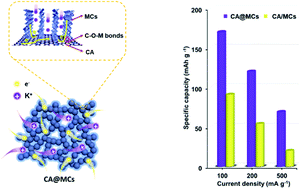Key to intimately coupling metal chalcogenides with a carbon nanonetwork for potassium-ion storage†
Abstract
Intimately coupling metal chalcogenides (MCs) with carbon materials is critical for boosting their application performances. However, since MCs and carbon materials are usually two types of incompatible materials, a non-uniform carbon/MC interface is easily formed, especially for multidimensional nanostructures. Herein, we propose an interfacial engineering strategy to enhance the interaction between a three-dimensional nanonetwork-structured carbon aerogel (CA) and MCs. The key to this strategy is the introduction of substantial oxygen-containing functional groups into the CA, which greatly improves its compatibility with MC precursors, and thus enables MCs to grow on the CA framework homogeneously. The optimized CA/MC interface enables extremely compact bonding interaction between the CA and MC nanosheets. Benefitting from a well-organized structure, the synthesized CA@MC composites show remarkable potassium-ion storage performances and electrochemical kinetic properties. As a demonstration, the CA@MoS2 composites show high reversible capacity (389 mA h g−1 at 100 mA g−1), excellent rate performance (capacity retention exceeds 40% with a 5-fold increase of the current density) and an enhanced ion diffusion rate when used as an anode material for potassium-ion batteries.



 Please wait while we load your content...
Please wait while we load your content...